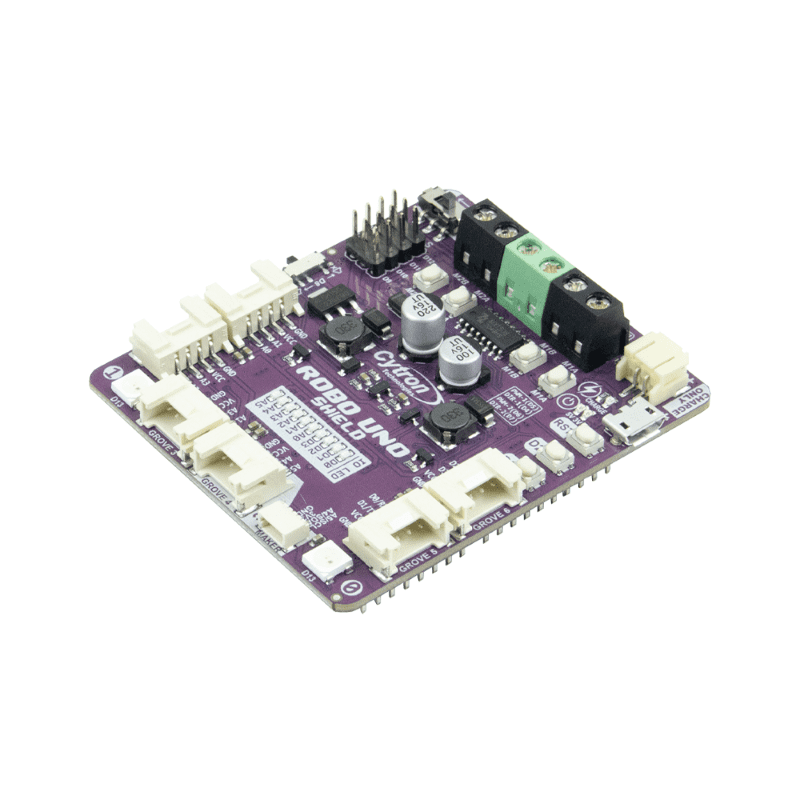




zł47.40 tax excl.
Cytron SHIELD-ROBO-UNO is a complete Arduino shield integrating DC motor control, servo ports, Grove/QWIIC/Stemma QT connectors, and a built-in LiPo/Li-Ion battery charging circuit. It enables rapid prototyping of robots and IoT projects, eliminating the need for complex wiring and multiple separate modules.
The Robo Uno Shield is an advanced add-on board for Arduino Uno and compatible boards, integrating key functions needed to build robots and automation projects without the need for complex wiring. It allows quick connection of motors, servos, Grove/QWIIC/Stemma QT sensors, and power from various sources, including LiPo/Li-Ion batteries with a built-in charging circuit and protection features. The module includes an integrated H-bridge for driving DC motors and dedicated servo ports. With support for Arduino IDE and mBlock, the shield is suitable for both beginners and advanced makers.
Manufacturer BTC Korporacja sp. z o. o. Lwowska 5 05-120 Legionowo Poland sprzedaz@kamami.pl 22 767 36 20
Responsible person BTC Korporacja sp. z o. o. Lwowska 5 05-120 Legionowo Poland sprzedaz@kamami.pl 22 767 36 20
Extension module (shield) with a signal generator for Arduino Pro Mini. It can trigger a sine, square or triangle waveform up to 3MHz. SparkFun BOB-11420
The Bluno Beetle Shield expands the Beetle\'s single analog and digital I/O pins to the 3 pin "gravity" interface, giving more power and ground connections and making it easier to attach gravity interface modules. It also includes a convenient external power supply and a 5-8v switch to power the board on and off. DFR0356
(DFR0105) Power Shield (Arduino Compatible)
Arduino Multifunctional Shield; LED, 7seg, buzzer, switch
No product available!
The shield allows for easier connection of cables to the Arduino UNO R3 board. Thanks to the screw connectors, it is possible to fast and secure the cable, goldpin connectors allow you to easily connect the servo, and the built-in female connectors allow you to put additional Arduino shields
Wixel Shield for Arduino
Shield with a 6-pin JST SH connector dedicated to Arduino Mini. It allows you to connect the GPS module with the GP-735 chip. SparkFun GPS-14030
The overlay solves the problem of limitations in the use of multiple overlays compatible with Arduino UNO R3. The board allows you to connect different shields without their mutual influence on each other (eg without conflict on the UART bus or GPIO lines). Extension dedicated for Arduino Mega and ADK devices. DFRobot DFR0256
GPS expansion module with 72-channel GNSS receiver SAM-M8Q dedicated to Arduino. The chip can receive data from all major positioning systems: GPS, GLONASS and Galileo. It has derived UART and I2C interfaces. Arduino ASX00017
No product available!
A module with a microSD card slot for Arduino. Equipped with two Grove connectors with I2C and UART for connecting additional sensors. Seeed Studio 103030005
Arduino IO Expansion Shield
Nano I / O Shield for Arduino Nano is an expansion board for Arduino Nano that provides digital, analog pins, power inputs and a connector for the Bluetooth module. DFRobot DFR0012
I/O pin expander designed for Arduino platforms. Provides 48 connections to increase the number of analog inputs, digital inputs and digital outputs. SparkFun DEV-11723
Controller module dedicated to Arduino boards. Equipped with 4 buttons, a two-axis joystick and an Xbee connector. DFRobot DFR0008

Cytron SHIELD-ROBO-UNO is a complete Arduino shield integrating DC motor control, servo ports, Grove/QWIIC/Stemma QT connectors, and a built-in LiPo/Li-Ion battery charging circuit. It enables rapid prototyping of robots and IoT projects, eliminating the need for complex wiring and multiple separate modules.
